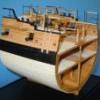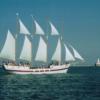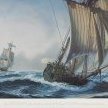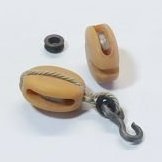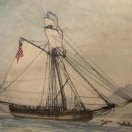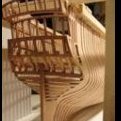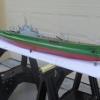Supplies of the Ship Modeler's Handbook are running out. Get your copy NOW before they are gone! Click on photo to order.
×
-
Posts
2,420 -
Joined
-
Last visited
Reputation Activity
-
 dvm27 got a reaction from Elijah in Medway Longboat 1742 by Chuck - FINISHED - 1/2" scale
dvm27 got a reaction from Elijah in Medway Longboat 1742 by Chuck - FINISHED - 1/2" scale
Great planking tutorial, Chuck. Of course, you could transfer those faired tick marks from your hull to the edge of the laser cut frames for the production run. One might introduce slight variations while raising the frames but overall it would be easy to adjust the spiled planks to these reference marks. But then you are providing the fish instead of teaching how to fish.
-
 dvm27 got a reaction from lmagna in Medway Longboat 1742 by Chuck - FINISHED - 1/2" scale
dvm27 got a reaction from lmagna in Medway Longboat 1742 by Chuck - FINISHED - 1/2" scale
Great planking tutorial, Chuck. Of course, you could transfer those faired tick marks from your hull to the edge of the laser cut frames for the production run. One might introduce slight variations while raising the frames but overall it would be easy to adjust the spiled planks to these reference marks. But then you are providing the fish instead of teaching how to fish.
-
 dvm27 got a reaction from Ryland Craze in Medway Longboat 1742 by Chuck - FINISHED - 1/2" scale
dvm27 got a reaction from Ryland Craze in Medway Longboat 1742 by Chuck - FINISHED - 1/2" scale
Great planking tutorial, Chuck. Of course, you could transfer those faired tick marks from your hull to the edge of the laser cut frames for the production run. One might introduce slight variations while raising the frames but overall it would be easy to adjust the spiled planks to these reference marks. But then you are providing the fish instead of teaching how to fish.
-
 dvm27 got a reaction from Chuck in Medway Longboat 1742 by Chuck - FINISHED - 1/2" scale
dvm27 got a reaction from Chuck in Medway Longboat 1742 by Chuck - FINISHED - 1/2" scale
Great planking tutorial, Chuck. Of course, you could transfer those faired tick marks from your hull to the edge of the laser cut frames for the production run. One might introduce slight variations while raising the frames but overall it would be easy to adjust the spiled planks to these reference marks. But then you are providing the fish instead of teaching how to fish.
-
 dvm27 got a reaction from AnobiumPunctatum in Medway Longboat 1742 by Chuck - FINISHED - 1/2" scale
dvm27 got a reaction from AnobiumPunctatum in Medway Longboat 1742 by Chuck - FINISHED - 1/2" scale
Great planking tutorial, Chuck. Of course, you could transfer those faired tick marks from your hull to the edge of the laser cut frames for the production run. One might introduce slight variations while raising the frames but overall it would be easy to adjust the spiled planks to these reference marks. But then you are providing the fish instead of teaching how to fish.
-
 dvm27 got a reaction from Chuck Seiler in Medway Longboat 1742 by Chuck - FINISHED - 1/2" scale
dvm27 got a reaction from Chuck Seiler in Medway Longboat 1742 by Chuck - FINISHED - 1/2" scale
Great planking tutorial, Chuck. Of course, you could transfer those faired tick marks from your hull to the edge of the laser cut frames for the production run. One might introduce slight variations while raising the frames but overall it would be easy to adjust the spiled planks to these reference marks. But then you are providing the fish instead of teaching how to fish.
-
 dvm27 got a reaction from Dowmer in Medway Longboat 1742 by Chuck - FINISHED - 1/2" scale
dvm27 got a reaction from Dowmer in Medway Longboat 1742 by Chuck - FINISHED - 1/2" scale
Great planking tutorial, Chuck. Of course, you could transfer those faired tick marks from your hull to the edge of the laser cut frames for the production run. One might introduce slight variations while raising the frames but overall it would be easy to adjust the spiled planks to these reference marks. But then you are providing the fish instead of teaching how to fish.
-
 dvm27 got a reaction from thibaultron in Medway Longboat 1742 by Chuck - FINISHED - 1/2" scale
dvm27 got a reaction from thibaultron in Medway Longboat 1742 by Chuck - FINISHED - 1/2" scale
Great planking tutorial, Chuck. Of course, you could transfer those faired tick marks from your hull to the edge of the laser cut frames for the production run. One might introduce slight variations while raising the frames but overall it would be easy to adjust the spiled planks to these reference marks. But then you are providing the fish instead of teaching how to fish.
-
 dvm27 got a reaction from mtaylor in Medway Longboat 1742 by Chuck - FINISHED - 1/2" scale
dvm27 got a reaction from mtaylor in Medway Longboat 1742 by Chuck - FINISHED - 1/2" scale
Great planking tutorial, Chuck. Of course, you could transfer those faired tick marks from your hull to the edge of the laser cut frames for the production run. One might introduce slight variations while raising the frames but overall it would be easy to adjust the spiled planks to these reference marks. But then you are providing the fish instead of teaching how to fish.
-
 dvm27 reacted to wefalck in Young America 1853 by EdT - FINISHED - extreme clipper
dvm27 reacted to wefalck in Young America 1853 by EdT - FINISHED - extreme clipper
Due to the structure of ropes - three or four more or less round strands winding around each other, it is difficult to measure a diameter. On a three-strand rope a caliper would touch on one side a strand and on the other side the space between two strands. This is why traditionally the size of ropes is given by the circumference, which can be measured by laying a thinner rope around it. In addition, direct measurement instruments, such as the vernier caliper, though known in principle for quite a while, did not come into common use until well into the 19th century.
This is, indeed, rather inconvenient from a modellers point of view, as the circumference of our 'ropes' would be very difficult to measure. However, as pocket calculators are common and virtually every mobile phone has a calculator, it should not be a big deal today to convert circumferences into diameter or vice versa. In many case a division/multiplication by 3 should be good enough.
-
 dvm27 reacted to EdT in Young America 1853 by EdT - FINISHED - extreme clipper
dvm27 reacted to EdT in Young America 1853 by EdT - FINISHED - extreme clipper
Young America - extreme clipper 1853
Part 292 – Mizzen Topmast Standing rigging
It has been a few weeks since the last post. Busy summer, but work has been proceeding to the tune of one or two hours a day. The work in this post was completed in early July. The first picture shows the mizzen topmast set in position with some of its standing rigging fitted.
The futtock shrouds for the topgallant mast shrouds were put on before the mast was set – as described for other masts in earlier posts. In this picture the six topmast shrouds were temporarily put over the masthead to allow the glue on the parceling to dry. The seizings were then tied. The serving ends have still not been clipped off. The deadeyes have been turned in on the starboard side. The next picture shows further work on the shrouds.
The parceling has been "tarred" with black acrylic paint, the deadeyes have been threaded and given an initial tension, and staves have been lashed on top and bottom. These were made from stiff blackened brass wire. Drawn boxwood staves that were used on some of the earlier rigging have proved too fragile and most of these have been replaced with wire. The next picture shows the backstays rigged and the mizzen topmast stay seized at the top collar and loosely fitted.
On all the masts the topmast backstays are the same size rope as the lower shrouds. This was discussed in an earlier post. These seemingly large sizes were mandated by the underwriters at the time, probably due to mishaps caused by overly aggressive captains. The backstays go over the masthead after the shrouds and before the forward stay. In the picture the starboard backstays have been secured. The next picture shows the lower ends.
The lengths of the backstay lanyards are longer than those on the lower shrouds to allow for more tightening of these longer, structurally important lines. The excess seizing ends will need to be clipped off. The lanyards are left loose to allow additional later tensioning. This progressive tensioning has been necessary on all standing rigging.
The next three pictures show the method used to secure the lower end of the mizzen topmast stay.
This stay cannot be secured before at least the initial tension is set on the backstays. The top end of the stay has the typical collar – served, parceled, leathered and the seized below the crosstrees. The forward connection shown above is made with a seizing through a shackled eyebolt on the main mast top. In the picture the stay is being pulled through the shackle and hauled tight. The lower end of this stay is served.
In the next step the stay is clamped as shown in the next picture before applying the seizings.
In the next picture the seizings have been applied.
I am using a rule-of-thumb of one seizing for every 3" of rope size – rounded up – so there are three seizings on the 8" stay. Rope size is circumference. After tying, the seizings as well as the served short end, are soaked with thinned, darkened glue. The excess ends are then clipped off when the glue dries. The final tension of this stay is set by hauling on the four backstays and the topmast shrouds.
Ed
-
 dvm27 reacted to michael mott in Young America 1853 by EdT - FINISHED - extreme clipper
dvm27 reacted to michael mott in Young America 1853 by EdT - FINISHED - extreme clipper
Ed Thanks for your very detailed description of the process. A question I do have, is why the ropes are sized by circumference and not by diameter? does this have anything to do with the act of handling a rope? Somehow the whole mindset of converting the circumference or diameter by 22/7 or 3.1416 one way or the other seems cumbersome. If I have say a 2 inch diameter ring or eye bolt, then it would seem easier to understand that the max diameter rope that could thread through it would be a less than 2 inch diameter, rather than less than a 6 inch circumference.
Michael
-
 dvm27 got a reaction from CaptainSteve in Making small nails with round head
dvm27 got a reaction from CaptainSteve in Making small nails with round head
For those wishing to purchase rivets and bolts of very small size check out https://model-motorcars.myshopify.com/collections/small-parts-hardware/rivets. They purchased Scale Hardware when they went out of business and have an ibcredible varieth of micro fasteners.
-
 dvm27 got a reaction from thibaultron in Making small nails with round head
dvm27 got a reaction from thibaultron in Making small nails with round head
For those wishing to purchase rivets and bolts of very small size check out https://model-motorcars.myshopify.com/collections/small-parts-hardware/rivets. They purchased Scale Hardware when they went out of business and have an ibcredible varieth of micro fasteners.
-
 dvm27 got a reaction from Canute in Making small nails with round head
dvm27 got a reaction from Canute in Making small nails with round head
For those wishing to purchase rivets and bolts of very small size check out https://model-motorcars.myshopify.com/collections/small-parts-hardware/rivets. They purchased Scale Hardware when they went out of business and have an ibcredible varieth of micro fasteners.
-
 dvm27 reacted to Javier Baron in Brighton Hog-boat or Hoggie by Javier Baron - FINISHED - Scale 1:130
dvm27 reacted to Javier Baron in Brighton Hog-boat or Hoggie by Javier Baron - FINISHED - Scale 1:130
Placed the sails, the hoggie is finished. It's an ugly boat, but I find it nice.
Javier
-
 dvm27 reacted to DocBlake in 17th Century Battle Station from HMS Mordaunt by DocBlake - FINISHED - 1:32
dvm27 reacted to DocBlake in 17th Century Battle Station from HMS Mordaunt by DocBlake - FINISHED - 1:32
A little more progress!
I glued the remaining half frames above the gun ports into place and worked on planking the exterior. The two channel wales and the great rail are swiss pear and the strake between them was supplied in both boxwood and holly. I chose the holly. The wale, black strake and two sheer strakes are ebony. The remainder of the outboard planking is boxwood. There will be a rosewood gunwale at the top of the bulwark. There were pre-drilled holes for the gun port lid control lines, but these had to be drilled through the framing to emerge just above the upper deck clamp's upper edge. With that done I completed the planking up to the sheer trim. The piece of trim was provided with either a double bead or triple bead design. I haven't decided which to use yet. Work turns to the upper deck next as we fit the support columns, knees and remaining ledges.
I enclosed photos made indoors with incandescent light as well as outdoors in daylight. Amazing how different the colors appear!
-
 dvm27 reacted to Maury S in Centerboard Schooner C. Chase 1846 by Maury S - FINISHED - Scale 1:48
dvm27 reacted to Maury S in Centerboard Schooner C. Chase 1846 by Maury S - FINISHED - Scale 1:48
Installation of square frames: This (Fr. H) will be the only square frame I install at this stage so I can fair the inner faces of the cant frames. The process is precise and relatively simple given the building board and its accessories. The building board had the full-breadth plan pasted-on. There are two Building board square frames [BBSQFR]. Their faces are square to the board. The BBSQFR faces are lined up with the aft lines of the frame on the plan using a machinist square.
A long 1/8" (thickness of the frame half) beam is set on top of the futtocks #3. The tops of Fut. #3 were cut precisely to length and the top timbers were cut proud. Since the beam is the same thickness as the frame, the face of the beam, clamped to the face of the BBSQFR aligns the aft edge of the frame pair with the plan on the board. Holding the Micro Mark digital level on top of the beam, I can make sure the frame is level side-to-side. The beam is clamped to the BBSQFR and the timber tops are clamped to the face of the beam. Ready for glue.
Maury
-
 dvm27 got a reaction from popeye the sailor in Albertic by michael mott - FINISHED - Scale 1:100 - RESTORATION - Bassett-Lowke Model
dvm27 got a reaction from popeye the sailor in Albertic by michael mott - FINISHED - Scale 1:100 - RESTORATION - Bassett-Lowke Model
It’s been an absolute pleasure to watch your restoration of this model Michael!
-
 dvm27 reacted to druxey in Medway Longboat 1742 by Chuck - FINISHED - 1/2" scale
dvm27 reacted to druxey in Medway Longboat 1742 by Chuck - FINISHED - 1/2" scale
Rather than packing tape, try 3M Magic tape. It is slightly frosted and takes pencil well. Even better is the 'temporary' version with re-positionable adhesive.
-
 dvm27 got a reaction from Jeronimo in HMS Kingfisher 1770 by Remcohe - 1/48 - English 14-Gun Sloop - POF
dvm27 got a reaction from Jeronimo in HMS Kingfisher 1770 by Remcohe - 1/48 - English 14-Gun Sloop - POF
Hey, does that mean we can all visit your workshop, Remco? I'm less than 8 hours away (by jet).
-
 dvm27 reacted to marsalv in Pandora by marsalv - FINISHED - 1:52
dvm27 reacted to marsalv in Pandora by marsalv - FINISHED - 1:52
Thank you guys.
The boats are finally completed. It is now still to finish the oars, masts and spars and install everything on the model.
-
 dvm27 got a reaction from Piet in HMS Kingfisher 1770 by Remcohe - 1/48 - English 14-Gun Sloop - POF
dvm27 got a reaction from Piet in HMS Kingfisher 1770 by Remcohe - 1/48 - English 14-Gun Sloop - POF
Hey, does that mean we can all visit your workshop, Remco? I'm less than 8 hours away (by jet).
-
 dvm27 reacted to archjofo in La Créole 1827 by archjofo - Scale 1/48 - French corvette
dvm27 reacted to archjofo in La Créole 1827 by archjofo - Scale 1/48 - French corvette
Hello Thomas,
recognized correctly, these are thin brass strips.
This I cut with the table saw of a brass sheet is 0.25 mm thick.
After the provisional adjustment of the ring diameter (slightly smaller than necessary), the two ends are brazed with silver solder.
For this I form the ring so that the obliquely filed ends touch on pressure.
I hope I have explained it somewhat understandable with my poor English and using the Google translation.
For safety, the following drawing:
-
 dvm27 reacted to druxey in HMS Kingfisher 1770 by Remcohe - 1/48 - English 14-Gun Sloop - POF
dvm27 reacted to druxey in HMS Kingfisher 1770 by Remcohe - 1/48 - English 14-Gun Sloop - POF
Keep the humidity up in the workshop, please!


